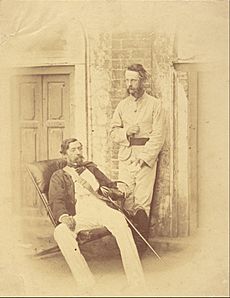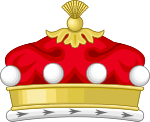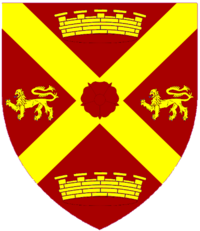Robert Napier, 1st Baron Napier of Magdala facts for kids
Quick facts for kids
The Lord Napier of Magdala
|
|
|---|---|
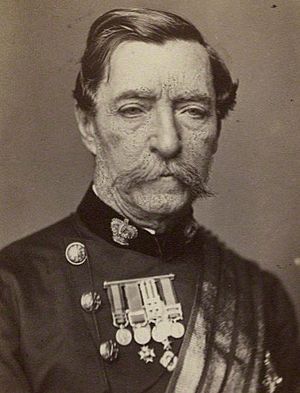 |
|
| Birth name | Robert Cornelis Napier |
| Born | 6 December 1810 Colombo, British Ceylon |
| Died | 14 January 1890 (aged 79) London, England, UK |
| Allegiance | |
| Branch | |
| Service years | 1828–1890 |
| Rank | Field marshal |
| Commands held | Bombay Army |
| Wars | |
| Alma mater | Addiscombe Military Seminary |
Field Marshal Robert Cornelis Napier, 1st Baron Napier of Magdala (6 December 1810 – 14 January 1890) was an important officer in the British Indian Army. He fought in several major conflicts. These included the First Anglo-Sikh War and the Second Anglo-Sikh War. He also played a key role in the Indian Rebellion of 1857 and the Second Opium War. Later, he led a famous expedition to Ethiopia (then called Abyssinia). There, he rescued hostages and defeated Emperor Tewodros II.
Contents
Robert Napier's Military Life
Starting His Army Journey
Robert Napier was born on December 6, 1810. His father was Major Charles Frederick Napier. Robert went to Addiscombe Military Seminary to study. After his training, he joined the Bengal Engineers in 1826.
He continued his training at the Royal School of Military Engineering in Chatham, England. In 1828, he was sent to India. He worked on important irrigation projects there. In 1841, he became a captain.
Fighting in the Sikh Wars
Napier served in the First Anglo-Sikh War. He was a chief engineer during the Battle of Mudki in December 1845. He was badly hurt at the Battle of Ferozeshah that same month. He also fought in the Battle of Sobraon in February 1846.
He was promoted to major in 1846. He then became the chief engineer at the siege of Kote Kangra.
During the Second Anglo-Sikh War, Napier helped plan the siege of Multan in 1848. He was injured again but recovered quickly. He was present when Multan was captured in 1849. He also helped capture the fortress of Chiniot.
Napier took part in the Battle of Gujrat in February 1849. He helped chase the Sikh army until they surrendered. He was promoted to lieutenant-colonel. After the war, he became the chief engineer for the Punjab region.
Protecting the North-West Frontier
In 1852, Napier led troops in the Hazara expedition. In 1853, he fought against the Afridis on the North-West frontier. He stopped a rebellion by the Afridi people. He was promoted to colonel in 1854.
Role in the Indian Rebellion
Napier was a key officer during the Indian Rebellion of 1857. He was the chief engineer during the second relief of Lucknow in November 1857. He was seriously wounded while meeting with other leaders.
He recovered and was present for the capture of Lucknow in March 1858. Napier then became second-in-command to Sir Hugh Rose. He led troops at the Battle of Morar in June 1858. After the city of Gwalior was captured, Napier chased and defeated a large enemy force. He helped end the war in January 1859.
Napier's Time in China
In January 1860, Napier took command of a division during the Second Opium War. He led an attack on the main northern fort in the Battle of Taku Forts in August 1860. He was very brave, with six bullet holes found in his clothes!
He helped secure the surrender of the Anting Gate in Peking in October 1860. He also protected Lord Elgin's entry into Peking. He was promoted to major-general in 1861.
Napier became a military member of the Council of the Governor-General of India in 1861. He briefly served as Governor-General. In 1865, he took command of the Bombay Army. He was promoted to lieutenant-general in 1867.
The Abyssinian Expedition
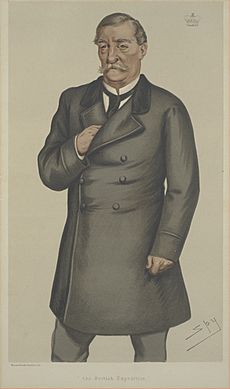
Napier became most famous for leading an expedition to Ethiopia in 1868. The Ethiopian ruler, Emperor Tewodros II, was holding European missionaries and British diplomats hostage. They were held in his mountain capital of Magdala.
Napier's army landed at Zula on the Red Sea in October 1867. They built a port there. Napier himself arrived in January 1868. He then led his troops into the Ethiopian Highlands.
The journey was very difficult. They had to cross 400 miles (640 km) of mountains. There were no roads or bridges. Napier's team planned everything carefully. They built roads and bridges as they went.
Napier also used smart diplomacy. He told the Ethiopians that the British only wanted to rescue the hostages. They did not want to conquer the country. He bought supplies from local leaders using silver coins. Many local leaders did not like Emperor Tewodros. This helped Napier.
Napier's troops reached Magdala on April 9, 1868. The next day, they defeated Tewodros's 9,000 troops. Only two British soldiers were lost. Emperor Tewodros tried to surrender his hostages. But Napier did not trust him. He ordered an attack on the mountain fortress on April 13, 1868.
After the battle, Napier ordered the destruction of Tewodros's cannons. He also had Magdala burned. This was done as revenge for the hostage-taking. His palace was searched by the soldiers.
After the Abyssinian campaign, Napier received many honors. He became a Fellow of the Royal Society. He was also made a Freeman of the City of London. He was given the title Baron Napier of Magdala in July 1868.
Later Years and Legacy
Napier became the Commander-in-Chief, India in 1870. He was promoted to full general in 1874. He then became the Governor of Gibraltar in 1876. In 1878, he was called back to London. He was asked to lead an army in case of war with Russia. When war did not happen, he went back to Gibraltar.
He was promoted to field marshal on January 1, 1883. Napier also held other important roles. He was the honorary colonel of a rifle corps. In 1887, he became the Constable of the Tower of London.
Robert Napier died in London on January 14, 1890, from influenza. He was given a state funeral. He was buried in St Paul's Cathedral on January 21, 1890.
Napier's Lasting Impact
In 1883, a large Armstrong cannon was placed in Gibraltar. The battery where it was located was named the Napier of Magdala Battery. In 1891, a statue of Napier on horseback was put up in London. It was later moved to Queen's Gate.
A building in London, Napier House Army Reserve Centre, is also named in his honor.
Honors and Awards
Napier received many important awards:
- Knight Grand Cross of the Order of the Bath (GCB) – 1868
- Knight Grand Commander of the Order of the Star of India (GCSI) – 1867
|
Family Life
In June 1840, Napier married Anne Pearse. They had three sons and three daughters. Sadly, his wife died in 1849 during childbirth. In April 1861, he married Maria Cecilia Smythe Scott. They had six sons and three daughters together.


